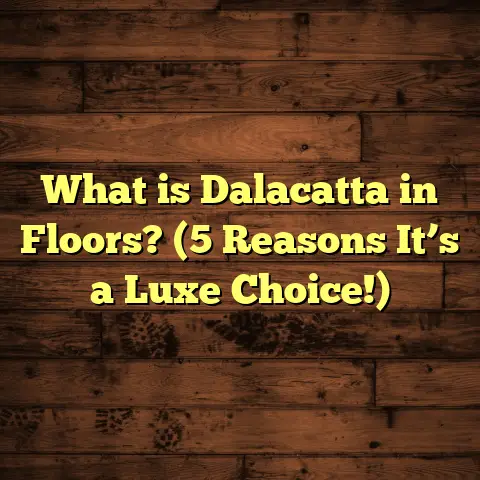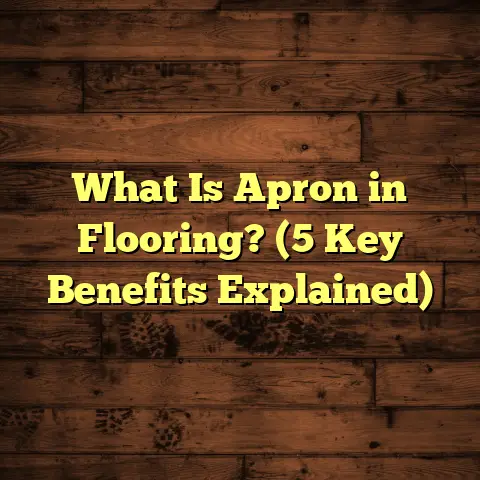What is Hardwood Flooring? (5 Benefits You Didn’t Know About)
I remember the first time I found myself standing in a client’s living room, staring down at an old, dull floor. It was one of those moments when you realize the entire look and feel of the house hinges on what’s underfoot. The dilemma was clear: should they invest in something flashy and new or stick with a classic? After years of experience in flooring, I always end up recommending hardwood flooring. Why? Because hardwood is more than just a surface; it’s an experience that grows richer with time.
If you’re reading this, you’re probably wondering what makes hardwood flooring so special. Maybe you’re considering it for your own home but want to know what you’re really getting into beyond the surface. Let me share with you some benefits of hardwood flooring that even many homeowners and contractors overlook, along with personal insights from my years in the field.
What Is Hardwood Flooring?
Hardwood flooring is solid wood planks milled from hardwood trees like oak, maple, walnut, or cherry. Unlike engineered hardwood or laminate, solid hardwood consists of a single piece of wood all the way through. This characteristic gives it strength and allows it to be sanded and refinished multiple times throughout its life.
But here’s something that often surprises people: hardwood floors are alive in a sense—they respond to changes in temperature and humidity by expanding and contracting. This means proper installation with expansion gaps and acclimation to the environment before laying down the planks is key.
I’ve installed hardwood floors in dozens of homes across different climates—from dry desert regions to humid coastal areas—and each setting requires unique considerations. The beauty of hardwood is its natural grain patterns and color variations that give each floor a distinct personality.
While hardwood floors are often praised for their elegance and timeless appeal, there’s much more beneath the surface that makes them an excellent choice for many homeowners.
1. Hardwood Floors Improve Indoor Air Quality More Than You Think
Most people don’t realize how much their flooring affects the air they breathe indoors. Carpets, while cozy, are notorious for trapping dust, allergens, pet dander, mold spores, and even chemical residues inside their fibers. Over time, these become a constant source of irritation for allergy sufferers and can degrade overall air quality.
When I worked with a family who had two young kids with asthma, they shared how their symptoms worsened whenever they vacuumed or walked on their carpeted floors. We replaced their carpets with oak hardwood flooring—and within a few weeks, they noticed fewer coughing fits and less sneezing.
Scientific studies back this up too. The American Lung Association notes that hard surface flooring like wood reduces indoor allergen accumulation by as much as 50% compared to carpets. Hardwood floors are smooth, easy to clean with a broom or microfiber mop, and don’t trap particles.
Here’s an actionable tip: For optimal air quality with hardwood floors, clean regularly using a vacuum with a HEPA filter or microfiber mop to capture dust instead of just moving it around.
2. Hardwood Flooring Can Increase Your Home’s Resale Value Significantly
You might have heard that hardwood floors add value to your home, but do you know by how much?
According to the National Association of Realtors (NAR), homes with hardwood floors sell for approximately 2% to 5% more than comparable homes with other flooring types. In some markets, especially where buyers prefer traditional aesthetics, that number can be even higher.
I remember a project where a client installed solid oak hardwood in their living room and kitchen area totaling about 1,000 square feet. When it came time to sell their home just two years later, they received offers above asking price by nearly $15,000—thanks in part to the upgraded floors.
Why does this happen? Hardwood flooring signals quality and durability. Buyers see it as a long-term investment because solid wood lasts decades when properly maintained. It’s also a neutral design element that complements various styles—which broadens appeal.
If you plan to sell your home within 5-10 years, investing in hardwood floors could pay off handsomely.
3. Hardwood Floors Age Gracefully and Gain Character Over Time
Unlike trendy flooring options that fade or get damaged beyond repair quickly, hardwood floors have this amazing ability to tell your home’s story through wear patterns, scratches, and color changes.
One of my favorite projects involved restoring a 100-year-old Victorian farmhouse. The original hardwood floors were almost hidden under layers of paint and dirt but still structurally sound. We carefully stripped and refinished the planks revealing beautiful grain patterns and subtle color variations that only come with age.
That patina—the soft sheen developed over years—is something you can’t replicate with new materials. It adds warmth and depth to any room.
Here’s another benefit: hardwood floors can be sanded and refinished multiple times (usually 3-5 times depending on plank thickness). This means if your floors get scratched or stained, you don’t have to replace them—you can simply refinish the surface and restore that fresh-new look.
Pro tip: Avoid harsh cleaning chemicals or abrasive tools that damage the finish; instead use mild detergents designed for hardwood care.
4. Hardwood Flooring Helps Regulate Indoor Temperature Naturally
You might not think of flooring as part of your home’s energy system, but wood actually acts as a natural insulator. Unlike tile or stone—both excellent but cold surfaces—hardwood retains warmth in the winter while remaining cool during hot summers.
In colder climates I work in during winter months, homes with hardwood floors tend to feel warmer underfoot compared to tile or laminate alternatives. Wood’s cellular structure traps air pockets which slows heat transfer—making rooms feel cozier without extra heating costs.
According to research published by the U.S. Department of Energy, wood flooring has an R-value (thermal resistance) between 0.71 to 1.02 per inch thickness—higher than tiles which typically range from 0.1 to 0.3.
How you can use this: Combine hardwood flooring with strategically placed area rugs in living spaces or bedrooms for added comfort without losing insulation benefits.
5. Hardwood Flooring Is More Sustainable Than You Probably Think
It’s easy to assume harvesting trees for hardwood flooring harms the environment. However, most responsible suppliers source wood from forests certified by organizations like the Forest Stewardship Council (FSC). These certifications ensure sustainable forestry practices including replanting trees and protecting biodiversity.
In fact, U.S. Forest Service data shows that sustainable forestry efforts have increased forest growth rates by about 2-3% annually over the past decade despite ongoing harvesting activities. This means we can responsibly use wood resources without depleting forests.
Additionally, reclaimed hardwood flooring—from old barns or warehouses—is gaining popularity among eco-conscious homeowners I work with. Reclaimed wood gives new life to materials that would otherwise be discarded and often carries unique textures and colors impossible to find in new lumber.
If sustainability is important to you, look for FSC-certified products or reclaimed wood options when planning your floors.
How FloorTally Makes Hardwood Flooring Projects Easier for Me
Estimating costs for hardwood flooring used to be one of the most stressful parts of my job. Between fluctuating material prices, labor rates that vary by region, waste factors due to cuts or damage—it was easy to underestimate or overbuy.
That changed when I started using FloorTally for my projects. This tool lets me input real-time local prices for materials and labor alongside room measurements and preferred waste factors. It then calculates an accurate total cost estimate—breaking down material versus labor costs clearly.
For example:
- Input: 1,200 sq ft living area
- Material: White oak hardwood at $7/sq ft
- Labor: Installation at $3/sq ft
- Waste factor: 7%
FloorTally quickly shows me total material cost ($8,988), labor cost ($3,600), waste material needed (about 84 sq ft extra), and overall project budget ($12,588).
This saves me hours of spreadsheet work and guesswork—and more importantly helps clients understand realistic budgets upfront without surprises later on.
Personal Stories from My Hardwood Flooring Experiences
Restoring History With Patina
A few years ago, I worked on an old farmhouse built in 1910 where the owners wanted to preserve as much original material as possible—especially the floors. After removing old carpet and peeling paint layers from the floorboards, we discovered stunning white oak planks underneath.
The floors had deep scratches and stains but were structurally intact. We carefully sanded them down and applied a natural oil finish instead of polyurethane to maintain breathability. The final look was stunning—the patina gave warmth and personality impossible to replicate with new materials.
The owners loved how their floors told stories of decades gone by; their home felt more rooted in history after the restoration.
Beachfront Challenges
Installing hardwood flooring near salty ocean air presents unique challenges I hadn’t encountered until I took on a project in Florida. Salt is corrosive to some finishes and humidity levels are high year-round which can cause wood expansion issues.
To combat this:
- We used engineered hardwood with top-quality aluminum oxide finish designed for moisture resistance
- Installed proper moisture barriers underneath
- Recommended regular maintenance such as cleaning salt residues quickly
The result? Beautiful floors that held up well despite harsh conditions—a great example of selecting materials tailored to environment.
More Tips When Choosing Hardwood Flooring
Species Selection
Different wood species have varying hardness levels measured on the Janka scale:
- Red Oak: Popular choice; Janka hardness ~1290 (good balance of durability & workability)
- Hard Maple: Harder than oak (~1450); lighter color; great for modern looks
- Walnut: Softer (~1010); rich dark tones; elegant appearance
- Hickory: Very hard (~1820); rustic look; durable for high traffic
Pick species based on your lifestyle needs—if you have kids or pets, harder woods withstand dents better.
Plank Width
Traditional floors use narrow planks (2-3 inches wide), which show less movement over time but take longer to install.
Wider planks (4-6 inches) are trendy now but may develop gaps due to seasonal expansion/contraction—choose based on climate stability.
Finish Options
Matte finishes hide scratches better but can show dirt easier; gloss finishes shine beautifully but highlight imperfections.
Oil-based finishes penetrate wood enhancing natural grain but take longer to dry; water-based finishes dry quickly and have less odor but slightly less rich color.
Installation Methods
- Nail-down is standard for solid hardwood on wooden subfloors
- Glue-down is common for engineered hardwood on concrete slabs
- Floating floors click together over underlayment—good DIY option but less stable long-term
Discuss options with your installer based on your home’s structure.
How Maintenance Impacts Longevity
Hardwood floors last decades if cared for properly. Neglect leads to scratched finishes, water damage, or warping which shorten lifespan drastically.
Here are some essential maintenance tips I always share:
- Wipe spills immediately—water is the enemy
- Use felt pads under furniture legs to prevent dents
- Avoid wet mopping; use damp microfiber mops instead
- Refinish every 7-10 years depending on wear
- Maintain indoor humidity between 35%-55% to minimize wood movement
The Cost Factor: What Should You Expect?
Hardwood flooring costs vary widely based on species, plank size, finish type, labor rates in your area, and project complexity.
Here’s a rough breakdown per square foot (materials + installation):
| Type | Cost Range ($/sq ft) |
|---|---|
| Basic Oak Solid | $6 – $12 |
| Exotic Hardwoods | $8 – $15 |
| Engineered Wood | $5 – $10 |
| Reclaimed Wood | $10 – $20 |
Labor varies too—from $2-$6 per sq ft depending on location and prep work needed.
Using tools like FloorTally helps me create accurate quotes factoring all these variables plus waste estimates—making budgeting easier for clients.
Why I Keep Coming Back To Hardwood Flooring
Over the years I’ve installed many kinds of flooring—tile, laminate, vinyl—but hardwood remains my favorite for its unmatched combination of beauty, durability, comfort, and value.
Every time I finish a project where homeowners choose hardwood:
- They tell me how cozy it feels underfoot
- How easy it is to keep clean compared to carpet
- How their homes feel warmer in winter without cranking heat
- How guests comment on the natural elegance
There’s something timeless about walking barefoot on real wood that synthetic materials just can’t match.
Some Questions You Might Be Asking
Q: What about scratches? Won’t hardwood get ruined easily?
A: Yes, hardwood can scratch but minor marks add character over time. Plus sanding & refinishing restore floors easily if needed—unlike laminate or vinyl which must be replaced if damaged badly.
Q: Can I install hardwood myself?
A: If you’re handy and have right tools (and solid subfloor), floating engineered hardwoods are DIY-friendly. But solid nailed-down hardwood usually requires professional installation for best results.
Q: How long does hardwood last?
A: With proper maintenance, 30+ years is common; some historic homes have original floors over 100 years old!
Final Thoughts
Hardwood flooring is more than just a stylish choice—it offers real benefits many people don’t initially see:
- Cleaner indoor air quality
- Increased home resale value
- Floors that improve aesthetically with age
- Natural temperature regulation
- Sustainable options that respect our planet
If you’re considering upgrading your floors anytime soon, think beyond looks and cost alone. Consider how your floor impacts daily life—comfort, health, energy usage—and long-term investment.
And remember: planning well using tools like FloorTally can help avoid surprises later while keeping your budget realistic.
I’d love to hear your experiences or questions about hardwood floors—feel free to share!





